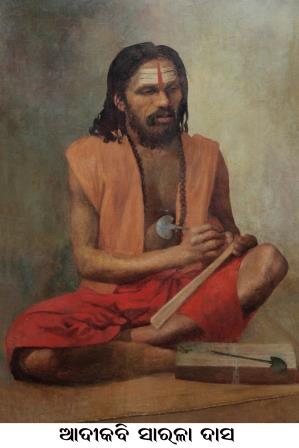Adikabi Sarala Das
Died :- Magha Shukla Saptami
Place of Birth :- Tentulipada, Jagatsinghpur

Adikabi Sarala Dasa, originator of Odia literature, was born in village Kanakavati Patana, otherwise known as Kanakapura in the modern Jagatsinghpur District. Best known for three Odia epics — Mahabharata, Vilanka Ramayana and Chandi Purana — he was the first scholar to write in Odia. His early name was Siddheswara Parida. The early life of Sarala Dasa is not accurately known. He was a contemporary of Gajapati king Kapilendra Dev. Though the actual date of his birth has not so far been determined, he can safely be placed to the 15th century. By then Odia language had developed to its modern form.
It is assumed that Sarala Dasa had no systematic early education, and what he achieved through self-education is attributed to the grace of Sarala, the Goddess of Learning. Though his early name was Siddheswara Parida, he was later known as Sarala Dasa, or 'Servant of Sarala'. A legend has it that Siddheswara as a boy was once ploughing his father's field and singing so melodiously that goddess Sarala stopped and listened to his song and blessed him with the power to compose beautiful poems.
Sarala Dasa wrote his epic poems at a religious establishment known as Munigosain and spent his last days in a mutt on the banks of river Budha nadi till his death on Magha sukla saptami.
Besides the three epics for which he is best known - Mahabharata, Vilanka Ramayana and Chandi Purana - Sarala Dasa also wrote the book Laxmi Narayana Vachanika.
Though Sarala Dasa followed the main outline of the Sanskrit Mahabharata in writing the Odia Mahabharata, he made numerous deviations and added to it copiously the stories of his own creation and various other matters known to him. In the final form Sarala Dasa's Mahabharata was a new creation analogous to Kalidasa's Raghuvamsa based on the Ramayana.
The verses of Sarala Dasa are simple, forceful and musical, without artificiality. Applying colloquial words for his poetical purpose, his writing was free from Sanskritisation. One metrical peculiarity of his style of writing is that both the lines of a verse do not contain equal number of letters though the last letters of both the lines produce the same sound. All of Sarala Dasa's works were composed with this metrical peculiarity, and, therefore, the metre used by him can be regarded as a direct descendant of that used in the folk songs.
The predominant sentiment in Sarala Dasa's poetry is not love but war. He was also motivated by a strong religious zeal to compose religious epics in a language intelligible to all and to make them available to the general public in Odisha.
The Chandi Purana was based on the well-known story of Goddess Durga killing Mahishasura as narrated in Sanskrit literature but here also the Sarala Dasa chose to deviate from the original epic at several points. His earliest work, Vilanka Ramayana, is a story of the fight between Rama and Shahasrasira Ravana.
For his saintly practices, his dedication to religious literature and his birth in a Khandayat family the Mukti Mandap Padit Sabha had conferred on him the title ‘Sudra Muni’ for which he is otherwise known as Sudra Muni Sarala Dasa.
There are several indications in his Mahabharata that he served as a soldier in the army of the Gajapati King of Odisha and his association with the army brought to him a variety of experiences which he has suitably mentioned at various places in the immortal epic.
Books
Poetry
- Sarala Mahabharata Adi parba Prathama Khanda
- Sarala Mahabharat Adi Parba Second Part
- Sarala Mahabharat Madya Parba Prathama Khanda
- Sarala Mahabharat Madhya Parba Second Part
- Sarala Mahabharata Bana Parba dwiteeya Khanda
- Sarala Mahabharata Bana Parba Prathama Khanda
- Sarala Mahabharat Udyoga Parba
- Sarala Mahabharat Birata Parba
- Sarala Mahabharat Sabha Parba Dwiteeya Khanda
- Sarala Mahabharat Sabha Parba Prathama Khanda
- Sarala Mahabharat - Kainshika Parba
- Sarala Mahabharat - Aswamedha Parba
- Sarala Mahabharat - Naree Parba
- Sarala Mahabharat -Shanti Parba
- Sarala Mahabharat - Mooshalee Parba
- Sarala Mahabharat - Swargarohana Parba
- Sarala Mahabharat - Ashramika Parba
Dictionary
Copyright © 2024 Odia Virtual Academy. All rights reserved Total Visitors- 1
Powered by: Odia Virtual Academy

